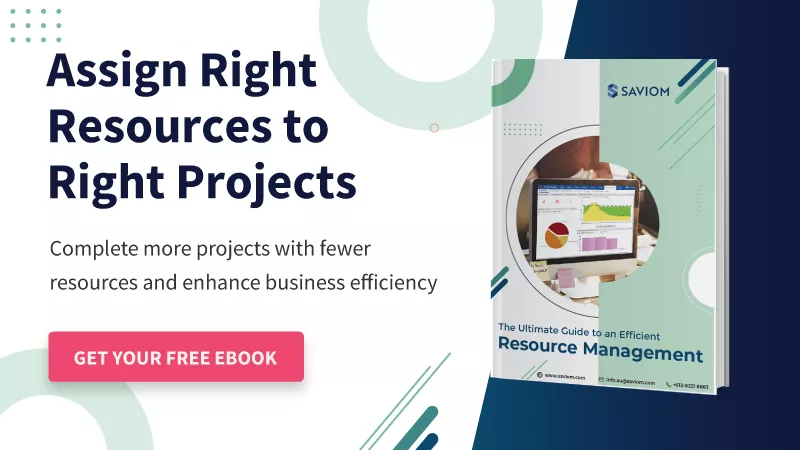A 2020 Professional Services Maturity™ Benchmark Report states,
“For a 100-person professional services firm, with average bill rates of $200 per hour, a 4% increase in utilization translates into 8,000 more billable hours per year, i.e., $1.6 million in incremental revenue.”
This report reiterates that a professional services firm must consider billable utilization of resources as one of the key performance indicators and take appropriate measures to maximize it.
It helps PSOs leverage the true potential of their talent pool to enhance profit margins and minimize billing loss. In addition, it improves the satisfaction and morale of the workforce, reducing unplanned attrition.
This article highlights the various strategies professional services firms can adopt to maximize resource utilization.
But first, let’s start with the basics.
What are the utilization benchmarks for professional service organizations?
The utilization rate of consultants in a professional services organization can influence its future business decisions and strategies. It is the percentage of time spent on billable projects versus the total available hours. Thus, it should ideally be maximized for higher ROI.
However, if professionals are consistently staffed to near total capacity with the purpose of maximizing billable utilization, they may experience burnout leading to attrition. To avoid this, many organizations set both a minimum and a maximum resource utilization target, allowing them to focus on operating within their Goldilock Zone.
The Goldilocks zone is the point at which all three critical aspects, including employee satisfaction, work quality, and profitability, are kept in balance.
Below are the utilization metrics for a nuanced understanding of how well the firm performs at various levels.
- Internal Utilization Benchmarks: Internal benchmarking is a process of looking within the organization to analyze performance, determining best practices, and identifying areas for improvement. This involves comparing different departments or teams’ operations and workflows against each other.
- External Utilization Benchmarks: These benchmarks consider industry data to see where your organization fits into the overall market. This is achieved by comparing performance, processes, and practices across different competitors in the industry.
- Ideal Utilization Rate: This metric shows how much of your consultant’s available time is spent on billable work. It can be calculated as: (Resource costs + overhead + profit margin) / (Total hours available x optimal billing rate)
- Realization Rate: The realization rate is the percentage of billed hours the resource has worked out of all their available billable hours. It can be calculated as: (Total billed hours / total billable hours) x 100%
- Agency Utilization Rate: This calculates the utilization rate for all the billable staff. It can be calculated as: (Total utilization rate of all employees / total employees)
Given the importance of utilization rates and benchmarks, the following are best practices to maximize utilization within professional services.
5 Strategies to maximize billable utilization in professional services
As we know, for professional services, high utilization is key to strong company growth. So here are a few best practices that organizations can adopt to optimize utilization and stay within the Goldilock zone:
Set utilization targets for internal and on-demand consultants
Many embedded service organizations depend on both external and internal resources for service delivery. However, utilization targets for on-demand or external consultants are not well-defined compared to internal personnel. This creates operational inefficiencies and makes it challenging for professional leaders to assess the performance and productivity of all consultants.
For instance, permanent consultants may spend their available hours on billable and other non-billable tasks that are important for business operations. As a result, their utilization target can be set around 70 – 80 % of their capacity to ensure that they are optimally utilized and not overworked. On the contrary, an on-demand resource’s utilization rate can be set close to 100% because they are usually hired on an hourly basis to perform a specialized function for the short term. These measures ensure both internal and on-demand consultants are optimally utilized and help managers predict more accurate utilization data.
Read More: How to Measure Different Types of Resource Utilization
Periodically assign stretch assignments to competent consultants
Stretch assignments can be one of the best strategies for employee development and maximizing utilization. These assignments are short-term projects beyond the current workforce’s capabilities and knowledge. It offers several benefits when leveraged correctly and in moderation. First, it provides professionals with unique opportunities to develop additional skills and competencies, diversify their portfolios, and demonstrate their merit.
Second, it helps firms identify suitable candidates for challenging future roles and positions. This increases the chances of these consultants being considered for multi-faceted projects with higher charge-out rates. Third, it helps bring in more revenue and increases billability. For instance, suppose that an accountancy firm deploys junior-level consultants on a skill-intensive financial fraud investigation task. If junior resources perform well, the management can prepare and assign them to future billable forensic accounting projects to enhance profitability.
Track and mobilize associates from non-revenue activities to billable work
For organizations to understand their overall utilization rates, it’s critically important to track both the billable and non-billable time of their consultants. Standard billable hours typically include working on client projects, communicating with them, and making requested revisions. Non-billable hours, on the other hand, are those activities that are not related to client projects and benefit your organization at large.
As associates deployed on BAU tasks don’t generate revenue or contribute to the overall billability. Thus, the onus is on managers to track and ascertain if the consultants are working on billable or non-billable activities. Following that, they can proactively mobilize these associates from non-billable activities to billable and strategic opportunities wherever possible. This way, PSOs can improve the billability of the resources and enhance organizational profitability.
Read More: Resource Management: A Comprehensive Handbook for Project Managers
Foster multiskilling to deploy consultants on diverse projects
Professional services organizations are involved in a large number of projects and require highly qualified and experienced consultants to address client needs. However, this workforce demand often sees a noticeable surge during seasonal fluctuations. If companies are ill-equipped to meet these sporadic spikes, this results in the loss of billable projects and clientele.
For instance, an IT consultancy firm has a pipeline project that requires consultants specialized in JAVA and C++. The consultants lack of expertise can make the firm lose a valuable customer. To combat this, managers can implement training and development programs to foster multiskilling. They can administer on-the-job training, technical training, or job shadowing opportunities to impart relevant industrial skills and knowledge to the workforce. This will help consultants comprehend the company’s broader business objectives and work on diverse projects. It will also reduce the monotony of the job and ultimately helps maximize their profitable utilization.
Maintain the right balance between permanent and contingent staff
Most professional service firms are required to cater to seasonal demand fluctuations. Therefore, managing this demand surge effectively is imperative to maintain business continuity. For instance, an accounting consultancy firm often faces high demands for accountants, tax analysts, budget analysts, etc., during the financial year-end. So, if your company lacks the right mix of skilled workforce, it will result in loss of business opportunities, client dissatisfaction, hamper market reputation, and reduced profitability.
To avoid this, managers must meticulously assess the nature of pipeline project demands and determine if they are one-time or recurring. Accordingly, they can hire and create the right mix of permanent and contingent consultants. They can also release the contingent workforce during seasonal troughs and reallocate their work to the existing permanent workforce to maintain billability. As the demand goes up during seasonal peaks, the contingent workforce can be rehired to support the permanent staff and avoid the loss of additional billable opportunities.
Read More: What is a Contingent Workforce and Why an Organization Needs It
Given the effective ways to maximize billable utilization in professional services firms, let’s look at how resource management software can help.
How can advanced resource management software help maximize consultants’ utilization?
It can be challenging to obtain a precise picture of your professional services company’s utilization rates. However, advanced resource management software can help these firms formulate an effective strategy to track and maximize the utilization of their workforce.
- The tool provides 360-degree visibility into all the consultants’ profiles, including skills, competencies, experience, etc., across the organization. The advanced filters help managers identify the best-fit consultants for projects and ensure optimal resource utilization.
- The forecasting capability can identify the skill gaps of consultants well in advance. This will enable them to hire or train existing consultants to bridge the gap. Moreover, the competency matrix within the tool also allows leaders to understand which consultants can be considered for stretch assignments.
- The tool can translate unrefined data to curate multidimensional utilization reports and heat maps to identify over/underutilization and take suitable measures to optimize the consultant’s time. Besides, forecast vs actual reports helps identify variances and take appropriate measures to improve future resource usage.
- Besides, using the software, managers can publish open positions for various projects across the organization. Consultants with matching skill sets can apply for suitable vacancies. That way, consulting managers can assess and book the best-fit resource for open roles. This promotes flexibility and encourages consultants to pursue their interests, thus enhancing productivity.
In a nutshell, these functionalities help a professional services firm to maximize consultants’ billable utilization rate efficiently.
Read More: Maximize Profitable Resource Utilization with Modern Resource Management Solution
Conclusion
Every professional services firm’s top priority is to expand its business and gain more clients. However, simply hiring more people will not help achieve these objectives. To pursue sustained growth and profits, maximizing the utilization of your existing workforce’s expertise is imperative. Effective resource utilization can pave the way for new market opportunities and broadening service lines while staying connected with customers’ ever-changing needs.
So, are you focusing on maximizing your consultant’s billable utilization?
The SAVIOM Solution
SAVIOM is the market leader in helping multinational clients manage their resources efficiently and effectively. With over 20 years of experience, this Australian-based MNC has a global presence across 50 countries and has helped 100+ clients with their Workforce Planning Software. Saviom also provides tools for Enterprise Project Resource Management, Project Portfolio Management, and Professional Service Automation.












